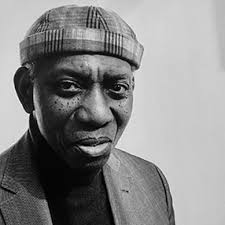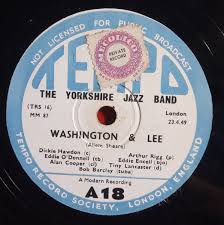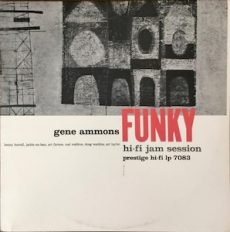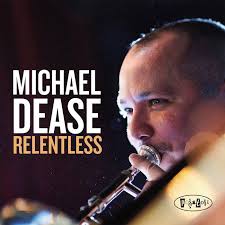
Jazz Poems
FEBRUARY IN SYDNEYDexter Gordon’s tenor sax
plays “April in Paris”
inside my head all the way back
on the bus from Double Bay
Round Midnight, the ‘50s,
cool cobblestone streets
resound footsteps of Bebop
musicians with whiskey-laced voices
from a boundless dream in French.
Bud, Prez, Webster, & The Hawk,
their names run together riffs.
Painful gods jive talk through
bloodstained reeds & shiny brass
where music is an anesthetic.
Unreadable faces from the human void
float like torn pages across the bus
windows. An old anger drips into my throat,
& I try thinking something good,
letting the precious bad
settle to the salty bottom.
Another scene keeps repeating itself:
I emerge from the dark theatre,
passing a woman who grabs her red purse
& hugs it to her like a heart attack.
Tremolo. Dexter comes back to rest
behind my eyelids. A loneliness
lingers like a silver needle
under my black skin,
as I try to feel how it is
to scream for help through a horn.
YUSEF KOMUNYAKAA
from Jazz Poems ~ Selected and Edited by Kevin Young
More Posts: book,classic,collectible,history,jazz,library,poet

Daily Dose Of Jazz…
Richard Hawdon was born in Leeds, England on August 27, 1927 and first studied cello before moving to trumpet in his mid-teens. After a stint with the Yorkshire Jazz Band he relocated to London, England in 1951, signing on with Chris Barber’s famed New Orleans Jazz Band.
Hawdon replaced trumpeter Ken Colyer in the Christie Brothers Stompers in 1952, remaining with the group for close to two years. While his Louis Armstrong-inspired approach earned favor among traditional jazz purists, he developed a modernist sensibility influenced by Clifford Brown.
Bop and progressive jazz followed in 1954 as a member of Don Rendell’s group in addition to a stint as trumpeter and arranger with Tubby Hayes. He joined his first big band in mid-1956 with Basil and Ivor Kirchin and the next year he joined John Dankworth in 1957. This would be his longest and most rewarding career collaboration.
Beyond recordings with Dankworth, the group performed with Louis Armstrong, teamed with the Duke Ellington Orchestra, he wrote and arranged a number of Dankworth staples including Cool Kate and One for Janet. Hawdon went on to freelance with bandleaders Sid Phillips, Harry Gold, Oscar Rabin, Terry Lightfoot, and backed singers Tony Bennett and Eartha Kitt during a stint with the house band at the London cabaret Talk of the Town.
On the eve of the demise of jazz as the leading music of the era, Dick relocated to Yorkshire, England in 1967 and led the Batley Variety Club’s house band. A year later, he developed a jazz course at the new City of Leeds College of Music, and became head of the school’s Light Music Department in 1972. Hawdon also led his own jazz quintet throughout the 1980s, and after retiring from academia in 1993 he turned his attention to the bass, playing in a series of local groups.
Trumpeter and bassist Dick Hawdon died June 24, 2009.
More Posts: bandleader,bass,history,instrumental,jazz,music,trumpet

Daily Dose Of Jazz…
Frances Wayne was born Chiarina Francesca Bartocci or Clara Bertocci on August 26, 1924 in Boston, Massachusetts. She graduated from Somerville High School. Moving to New York City in her teens she sang in an ensemble led by her brother, saxophonist Nick Jerret.
In the early 1940s she recorded with Charlie Barnet’s big band, and in 1943 sang with Woody Herman’s band. Marrying Neal Hefti in 1945, Frances soloed in her husband’s big band formed in 1947. In addition to her solo career she sang with Hefti into the 1950s.
She later sang with smaller ensembles featuring Hank Jones, Milt Hinton, Jerome Richardson, Richie Kamuca, John LaPorta, Billy Bauer and Al Cohn. On The Woody Herman Show broadcasted on the radio, Wayne was his female vocalist.
On February 6, 1978, vocalist Frances Wayne, who received the 1946 Esquire Award as Best New Female Vocalist, died after suffering from cancer over an extended period in her hometown at age 58.
More Posts: bandleader,history,instrumental,jazz,music,vocal

Requisites
Funky ~ Gene Ammons All-Stars | By Eddie Carter
Next from the library is a significant 1957 jam session led by tenor saxophonist Gene Ammons with a first-class supporting cast titled Funky (Prestige PRLP 7083). His bandmates on this date are Art Farmer on trumpet, Jackie McLean on alto sax, Mal Waldron on piano, Kenny Burrell on guitar, Doug Watkins on bass, and Art Taylor on drums. My copy is the 1986 U.S. Original Jazz Classics Mono reissue (Prestige OJC-244).
Kenny Burrell’s Funky starts Side One with Doug’s bass intro, developing into the ensemble’s relaxing opening chorus. Gene solos first, making effective use of his mellow tone in a flawless opening statement. Kenny eases into a delightful reading next, complementing the rhythm section perfectly. Jackie cruises methodically into a casually carefree performance by Art, bristling with good feelings. Mal comes in next with a swinging presentation, and then Doug closes with a laid-back comment ahead of the ensemble’s closing chorus.
Pint Size, the first of two tunes by tenor saxophonist Jimmy Mundy, concludes the first side leisurely with the septet’s tight harmony in unison with the melody. Ammons lays down a compelling opening solo, emitting an infectious excitement as it unfolds. Farmer sustains the contagious rhythm next by inviting us to snap our fingers, tap our toes or get up and dance. McLean provides equal amounts of passion and flair in the third reading. Burrell does a masterful job executing a series of skillful phrases, and Waldron approaches the finish line with a sparkling performance culminating in the climax.
Stella By Starlight by Victor Young and Ned Washington first appeared in the 1944 supernatural horror film The Uninvited and opens Side Two. The ensemble opens deceptively at a slow ballad tempo with a warm, sinuous intro by Wal and Gene’s gentle theme. The pace picks up dramatically for each solo, beginning with the leader delivering his message confidently. Art takes center stage next for some enthusiastic solo work, and then Jackie swings with a happy approach, showing remarkable skill. Kenny echoes the merriment of his colleagues with an enthusiastic performance. Mal ends with a quaint interpretation prior to the leader’s return to the slow tempo for the close.
Jimmy Mundy’s King Size sets up things with a solo introduction by Ammons that segues into the group’s lively melody. Gene swings with immense energy in an exquisite opening solo, with Farmer shadowing him for one chorus. The trumpeter answers him with some down-home cooking for an incredibly flavorful dish. McLean soars skyward with avid enthusiasm in the next reading. Burrell’s guitar surges with scintillating radiance; then, Waldron takes the spotlight last for an adrenaline-fueled solo powered by the rhythm section’s dazzling groundwork. The principal soloists share a few final observations in the front line’s closing chorus, featuring a brief solo by Watkins into the song’s finale.
Bob Weinstock supervised the original session of Funky, and the remastering of Rudy Van Gelder’s original mono tapes by Fantasy is superb, with an excellent soundstage of all the instruments emerging through the speakers vividly! Gene Ammons played and recorded with some of the greatest names in jazz. He got his nickname “Jug” from Billy Eckstine, whose band he was a member of in 1944, and he later played in Woody Herman’s Second Herd. Gene Ammons’s jazz career was interrupted twice because of two prison sentences (1958-1960) and (1962-1969) for narcotics possession.
He lost his battle against cancer on August 6, 1974, at the age of forty-nine. Gene Ammons and his bandmates are in breathtaking form and tone throughout this album, and the music heard flows as naturally as water downhill into a stream. If you are a fan of his or are just discovering his music, I hope you will consider Funky by Gene Ammons for a spot in your library on your next record-shopping trip. It is a well-rounded program of bop and soul jazz from Prestige, the label known for outstanding jam session LPs during the fifties and sixties!
~ Stella By Starlight – Source: JazzStandards.com ~ Gene Ammons – Source: Wikipedia.org © 2024 by Edward Thomas Carter
Daily Dose Of Jazz…
Michael Patrick Dease was born August 25, 1982 in Augusta, Georgia. He attended John S. Davidson Fine Arts Magnet High School where he studied saxophone and voice. He achieved all-state vocal honors for three consecutive years.
At 17 Michael taught himself to play trombone and was soon invited to join the inaugural class of the Juilliard jazz studies program by Wycliffe Gordon. He earned both his bachelor’s and master’s degrees while at the school. While at Juilliard he won many awards, including the Frank Rosolino Award, J.J. Johnson Award, the Sammy Nestico Jazz Composers Award, ASCAP Young Jazz Composer Award, and the Fish Middleton Jazz Competition.[2]
He began his career in Illinois Jacquet’s Big Band in 2002, and has performed as a featured member of the big bands of Christian McBride, Roy Hargrove, Nicholas Payton, Jimmy Heath, Charles Tolliver and the Dizzy Gillespie All-Stars. He also performs with small groups led by Claudio Roditi, Rodney Whitaker, Wycliffe Gordon, and David Sanborn. He has toured extensively throughout Europe, Asia, North America and Latin America. In addition to performance, Dease serves as president and producer at his jazz record label, D Clef Records.
Dease conducts master classes and workshops at universities and conservatories around the world, holds the position of Associate Professor of Jazz Trombone at the Michigan State University College of Music. He has held similar positions at Queens College, CUNY, and The New School for Jazz and Contemporary Music in New York City.
Tenor and bass trombonist, composer, producer and educator Michael Dease continues to perform, compose, record and educate.
More Posts: bandleader,bass,composer,educator,flugelhorn,history,instrumental,jazz,music,piano,producer,saxophone,trombone,trumpet




